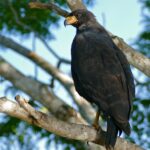Great Black Hawks, also known as Buteogallus urubitinga, are birds of prey that consume a diverse range of prey species. Their diet includes amphibians, fishes, lizards, snakes, birds, small mammals (including bats), crabs, large insects, carrion, and even fruits. These hawks employ various hunting techniques to capture different prey, such as perching and dropping down onto unsuspecting prey, searching forest trees on the wing, hunting on the ground, and searching for prey among floating vegetation in shallow waterways.
Frequency of Feeding for Great Black Hawks
The frequency of feeding for Great Black Hawks can vary depending on several factors, such as the availability of prey, the age and size of the hawk, and the time of year. However, some general observations about their feeding habits include:
-
Nestlings and Juveniles: Newly hatched Great Black Hawks require frequent feedings, with the parents bringing food to the nest every 1-2 hours during the day. As the nestlings grow, the frequency of feedings may decrease, but they still require multiple meals throughout the day.
-
Adults: Adult Great Black Hawks typically eat 1-2 times per day, with larger prey items being consumed less frequently. They may go several days without feeding if they have successfully captured a large prey item, such as a small mammal or a large fish.
-
Breeding Season: During the breeding season, when the female is incubating eggs or brooding chicks, the male is responsible for providing most of the food for the family. The male may need to hunt more frequently to ensure that the female and the young have enough to eat.
-
Non-Breeding Season: Outside of the breeding season, Great Black Hawks may be more opportunistic in their feeding, taking advantage of available prey as they encounter it throughout the day.
Hunting Techniques and Prey Preferences
 Image source: Great Black Hawk by Bernard DUPONT
Image source: Great Black Hawk by Bernard DUPONT
Great Black Hawks employ a variety of hunting techniques to capture their prey, including:
- Perching and Dropping: The hawks will perch on a high vantage point, such as a tree branch or power line, and then swoop down to catch unsuspecting prey on the ground or in the water.
- Aerial Hunting: They may also hunt on the wing, searching for prey in the forest canopy or along the edges of waterways.
- Ground Hunting: These hawks will also hunt on the ground, walking and stalking their prey.
- Aquatic Hunting: They are known to search for prey among floating vegetation in shallow waterways, such as marshes and mangrove swamps.
The specific prey that Great Black Hawks target can vary depending on the local availability and abundance of different species. However, they are known to primarily feed on:
- Amphibians: Frogs, toads, and salamanders
- Fishes: Small to medium-sized fish, including those found in rivers, streams, and coastal waters
- Reptiles: Lizards, snakes, and small crocodilians
- Birds: Small to medium-sized birds, including other raptors
- Mammals: Small mammals, such as bats, rodents, and small marsupials
- Invertebrates: Crabs, large insects, and other aquatic invertebrates
Nesting and Breeding Behavior
Great Black Hawks build a platform nest made of sticks constructed high up in an emergent tree or on power poles. The female lays one egg, which is white with red to purplish-brown markings. The eggs must be incubated for between 35-37 days. After the nestling hatches, it will grow quickly, and the male will work hard to bring enough food to the nest for the female and his offspring.
Habitat and Distribution
Great Black Hawks are found in various habitats, including lowland rainforest, mountain rivers, coastal mangrove swamps, and wooded streams. They are non-migratory in most of their range but may engage in some altitudinal migrations in Argentina during the non-breeding season.
Conservation Status
Great Black Hawks have a conservation status of Least Concern, but they might be at risk from habitat loss and shooting in some areas. However, their future looks promising, with a stable population in most of their range.
References:
– All About Birds: Common Black Hawk
– The Peregrine Fund: Great Black Hawk
– Audubon: Common Black Hawk
– All About Birds: Common Black Hawk Overview
– Animalia: Common Black Hawk


